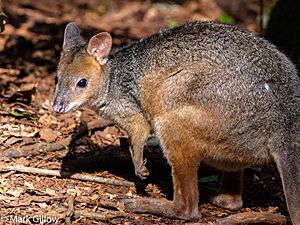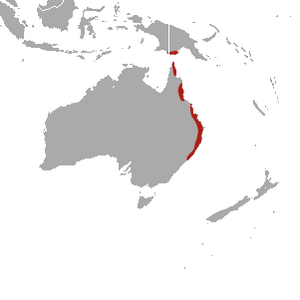Red-legged pademelon facts for kids
Quick facts for kids Red-legged pademelon |
|
|---|---|
 |
|
| Thylogale stigmatica | |
| Conservation status | |
| Scientific classification | |
| Genus: |
Thylogale
|
| Species: |
stigmatica
|
 |
|
| Red-legged pademelon range | |
The red-legged pademelon (Thylogale stigmatica) is a small macropod. This means it's a type of marsupial, like a tiny kangaroo or wallaby. You can find these animals in northeastern Australia and in New Guinea.
In Australia, they live in different spots from the top of Cape York Peninsula in Queensland down to Tamworth in New South Wales. In New Guinea, they live in the southern lowlands.
Red-legged pademelons usually like to be alone. But sometimes, when they are eating, they might gather in groups. They mostly live in rainforests, where they are hard to see. Overall, they are not considered in danger. However, in New South Wales, they are seen as a vulnerable animal. They eat fallen fruit, leaves, and grasses. These pademelons weigh about 2.5 to 7 kilograms (5.5 to 15.4 pounds). They are 38–58 centimeters (15–23 inches) long, with a tail that is 30–47 centimeters (12–18.5 inches) long.
There are four different types, or subspecies, of the red-legged pademelon:
- T. s. stigmatica, found near Cairns in Queensland.
- T. s. coxenii, found in Cape York Peninsula.
- T. s. orimo, found in New Guinea.
- T. s. wilcoxi, found in southern Queensland and New South Wales.
Contents
About Red-legged Pademelons
The red-legged pademelon is a marsupial that lives in rainforests. Marsupials are special because their babies are born very tiny and not fully developed. The baby pademelon then crawls into its mother's pouch. It stays there, drinking milk and growing, until it's big enough to come out.
These pademelons live in rainforests and also in more open areas. They are the only type of wallaby that lives on the ground in the Wet Tropics rainforests. The specific type we are talking about is Thylogale stigmatica. It belongs to the family called Macropodidae, which includes all wallabies and kangaroos.
What They Look Like
Their Fur Color
Red-legged pademelons have soft, thick fur. Their back is grey-brown, and their belly is cream-colored. Their cheeks, front legs, and the inside and outside of their back legs are a rusty brown. This rusty color on their legs is how they got their name! They also have a light cream stripe on the outside of their thigh. Pademelons that live in rainforests are usually darker than those from open areas.
Other Physical Features
Their tail is short and thick. An average-sized pademelon can stand about 76 centimeters (2.5 feet) tall when upright. When not standing, they are 35–58 centimeters (14–23 inches) long. Their tail is 30–47 centimeters (12–18.5 inches) long. They weigh between 2.5 and 7 kilograms (5.5 and 15.4 pounds).
Where They Live
Because people have cleared land, the areas where red-legged pademelons live have become smaller. However, they are still common where their homes remain. They are not too bothered by careful logging of trees. Their homes are not continuous, especially in the north. This is because they need certain types of plants for good cover.
Red-legged pademelons seem to like rainforests the most. But you can also find them near other types of forests. Even though a lot of rainforest has been cleared, there are enough parks and protected areas to keep them safe. Sometimes, clearing a forest can even help them a little. More small patches of forest mean more open grassy areas. These areas give the pademelons plenty of food. Only two subspecies live in Australia: Thylogale stigmatica and Thylogale wilcoxi.
Life Cycle and What They Eat
What They Eat
Red-legged pademelons mostly eat leaves that have fallen to the ground. But sometimes, they eat fresh leaves too. They also enjoy fruits and berries from bushes. In the southern part of their home range, they eat the fruit of the Moreton Bay Fig. In the northern part, they eat the fruit of the Burdekin plum. These two fruits are very important food sources for them.
They sometimes eat fishbone fern, king orchid, and grasses like Paspalum notatum and Cyrtococcum oxyphyllum. Red-legged pademelons also eat tree bark and cicadas. They can affect how the rainforest grows because they nibble on young trees. This can slow down the trees' growth or even kill them. They are one of the few animals that can eat the leaves of the Gympie Gympie plant (Dendrocnide moroides). This plant has a special chemical that can sting other animals.
Their Life Cycle
Red-legged pademelons usually live for about 4 to 9.7 years. Their lifespan can be shorter because of predators or forest fires. After a forest fire, there is less forest cover. This means it's easier for predators to find them.
How They Reproduce
Pademelons are pregnant for about 28–30 days. Their female cycle is 29–32 days long. Mating happens just a few hours after a baby is born. You can tell the gender of a baby in the pouch when it's 3 to 4 weeks old. The baby stops attaching to the teat at 13–18 weeks. Its ears stand up at 15–18 weeks, and its eyes open at 16–18 weeks. Hair starts to show at 19–21 weeks.
Young pademelons start to peek out of the pouch at 22–26 weeks. They leave the pouch for good at 26–28 weeks. They begin eating solid food about 66 days after leaving the pouch. Females can have their own babies at about 48 weeks old. Males are ready to mate at about 66 weeks old. Then the whole process starts again! When a baby is born, it's tiny and blind. It has only been developing for 3 to 6 weeks. Its limbs are not fully formed, but its front legs are strong enough. They help it crawl through its mother's fur to reach the pouch. Soon after giving birth, the female can become pregnant again.
Parental Care
If the female gets pregnant again, the new tiny embryo (called a blastocyst) stops growing for a while. It stays in this paused state until its older sibling is ready to leave the pouch. As soon as the young pademelon, called a joey, is old enough to leave the pouch, the paused embryo starts growing again.
Even after a young pademelon leaves the pouch, it often puts its head back in to drink milk. It only uses the same teat it used when it was inside the pouch. This amazing system allows the mother to make two different kinds of milk. One type is for the older joey that has left the pouch. The other type is for the younger, less developed joey still inside the pouch. This way of reproducing, called embryonic diapause, is also found in honey possums, bats, and seals. It's a very clever way to have babies. If a young animal dies or gets lost, the paused embryo can quickly start growing to replace it.
Special Abilities
Female pademelons have a pouch where they keep their babies. These babies are not fully developed when they are born. Mother red-legged pademelons make soft clucking sounds to call their young. They are often found in small groups. They look for food about 30-50 meters apart. This way, they can warn each other if predators are coming. They mostly come out at night.
How They Behave
Red-legged pademelons act differently depending on the time. They are least active around midday and midnight. In the late afternoon, evening, and early morning, you can see them eating grass. They graze in open areas near the rainforest edges. But if something scares them, they quickly run back into the forest.
They are usually alone, but they might group together at night when feeding on grasslands. They eat at equal distances from each other. One dominant pademelon seems to control their feeding area and how far apart they stay. They talk to each other using sounds and by thumping their back feet on the ground. They use different sounds when they interact. If they are fighting, or if a female doesn't want to mate, they make a harsh, rough sound. Males make soft clucking sounds when they are trying to attract a female. Mothers make similar sounds when calling their babies.
Their strong family groups, along with their speed and quickness in the rainforest, help protect them. They are safe from most attacks by wild animals. When a pademelon rests, it sits on the base of its tail. It puts the rest of its tail between its back legs. Then, it leans back against a rock or a small tree. When it falls asleep, its head leans forward to rest on its tail or on the ground.
The main predators of Thylogale stigmatica are dingoes, tiger quolls, amethystine pythons, and sometimes wild dogs. More pademelons are caught by predators after a forest fire. This is because there is less forest cover for them to hide in. They find predators by spreading out when they look for food. Each pademelon can watch for predators in its own area. If a predator is seen, they warn others by thumping their back legs on the ground.
See also
 In Spanish: Pademelon de patas rojas para niños
In Spanish: Pademelon de patas rojas para niños


